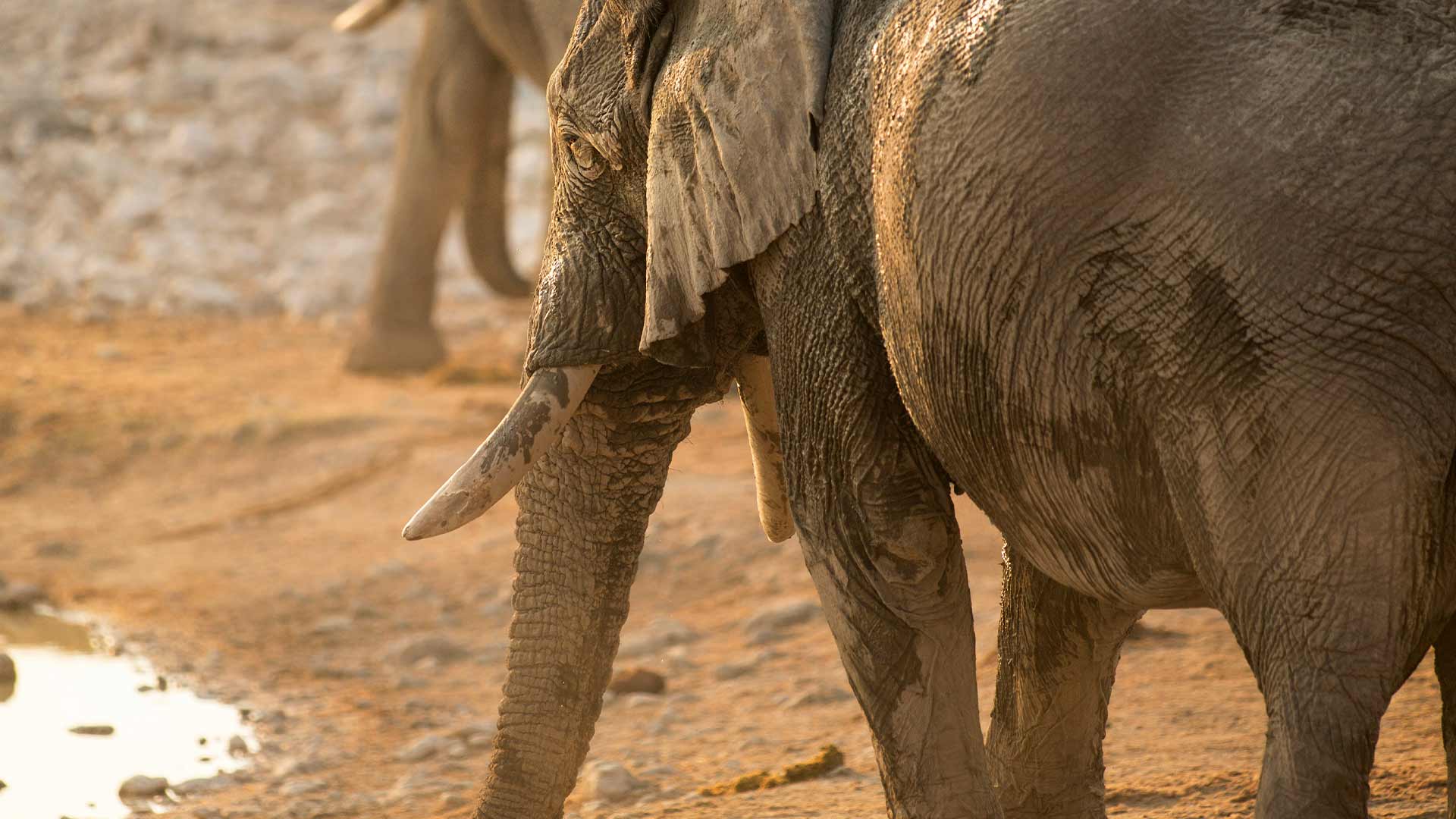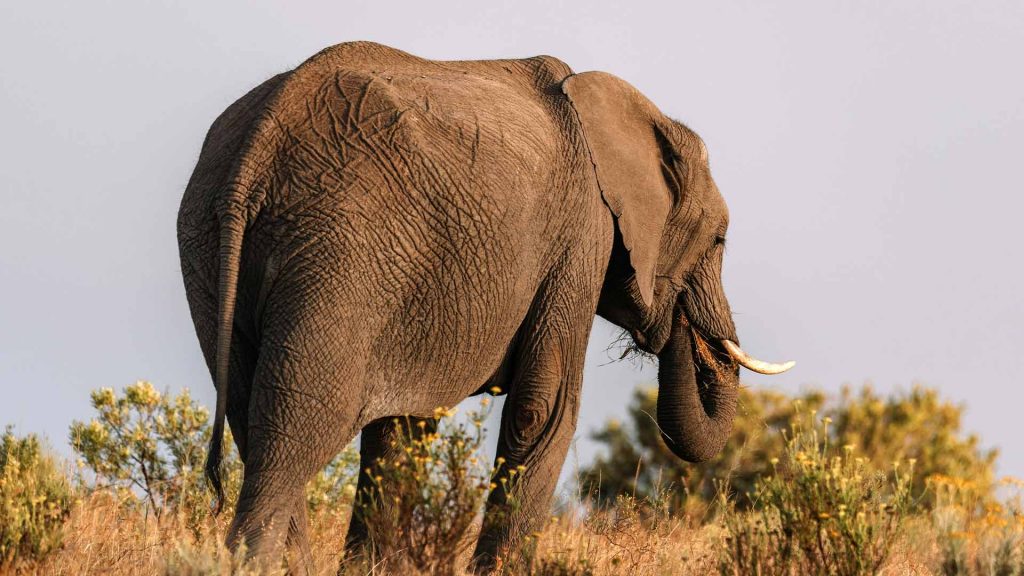African Elephant
Loxodonta africana, or the African elephant, is the largest terrestrial animal, recognized for its remarkable intelligence, tight-knit social groups, and key ecological impact throughout Africa’s varied environments. Learn about their physical description, behaviour, habitat, diet, and geographical distribution.

Overview
The African elephant, scientifically known as Loxodonta africana, is the largest land mammal on Earth and a symbol of Africa’s rich wildlife heritage. Known for their immense size, intelligence, and complex social structures, African elephants are a keystone species, playing a critical role in maintaining the biodiversity of the ecosystems they inhabit.
Species in Africa
- Savanna Elephant (Loxodonta africana): The largest elephant species, inhabiting the grassy plains and woodlands of sub-Saharan Africa.
- Forest Elephant (Loxodonta cyclotis): Smaller and darker than savanna elephants, these elephants reside in the dense forests of Central and West Africa. They have straighter tusks and more rounded ears.
Scientific Classification
- Kingdom: Animalia
- Phylum: Chordata
- Class: Mammalia
- Order: Proboscidea
- Family: Elephantidae
- Genus: Loxodonta
- Species: Loxodonta africana (Savanna elephant), Loxodonta cyclotis (Forest elephant)
Description
Elephants are renowned for their impressive size, distinctive trunks, and large ears. They exhibit remarkable intelligence and display a range of emotions.
Size
African elephants are the largest of the elephant species. Savanna elephants, the larger of the two subspecies, can stand up to 3.3 meters (10.8 feet) tall at the shoulder and weigh between 4,000 to 7,000 kilograms (8,818 to 15,432 pounds). Forest elephants are smaller, standing up to 2.5 meters (8.2 feet) tall and weighing between 2,000 to 4,000 kilograms (4,409 to 8,818 pounds).
Trunk
The elephant’s trunk, an elongated fusion of the nose and upper lip, is an incredibly versatile organ used for breathing, smelling, touching, grasping, and producing sound. It contains around 40,000 muscles.
Trucks
Both male and female elephants have tusks, which are elongated incisor teeth. Tusks are used for digging, stripping bark from trees, and as weapons in fights.
Ears
The large ears of African elephants serve multiple purposes, including temperature regulation and communication. The ears have extensive networks of blood vessels that release heat, and their flapping helps cool the blood.

Behavior, Diet, Reproduction, and Lifespan
Behaviour
Elephants are highly social animals, living in matriarchal family groups. The social structure and behavior of elephants are complex and include strong familial bonds and sophisticated communication methods.
- Social Structure: Family groups are led by the oldest female, known as the matriarch. These groups consist of her offspring and their young. Male elephants usually leave the group when they reach adolescence and may live solitary lives or form loose bachelor groups.
- Communication: Elephants communicate through a combination of vocalizations, body language, and seismic signals. They use low-frequency sounds, inaudible to humans, to communicate over long distances.
Diet
African elephants are herbivores with a diet consisting of grasses, leaves, bark, fruits, and roots. They can consume up to 150 kilograms (330 pounds) of vegetation daily.
- Feeding Behavior: Elephants use their trunks to pluck leaves and fruits, strip bark, and uproot grasses. They spend up to 16 hours a day feeding.
- Water Dependency: Elephants require large quantities of water and often travel great distances to find reliable water sources. They can drink up to 200 liters (52 gallons) of water in a single day.
Reproduction and Lifespan
Female elephants reach sexual maturity between 10 to 12 years of age. After a gestation period of 22 months, the longest of any mammal, a single calf is born. Calves are highly dependent on their mothers for the first few years of life.
In the wild, African elephants can live up to 60 to 70 years. Lifespan is influenced by environmental conditions, human activities, and social factors.
Habitat and Geographical Distribution
African elephants are found in a variety of habitats across sub-Saharan Africa, from savannas and forests to deserts and swamps. Their geographical distribution is extensive, reflecting their adaptability to different environments.
In Kenya, elephants are commonly found in Amboseli National Park and Tsavo National Park. Amboseli, situated at the base of Mount Kilimanjaro, offers a unique ecosystem where elephants are a prominent feature. Tsavo is known for its large elephant population and diverse habitats, ranging from grasslands to dense forests.
In Tanzania, the Serengeti National Park and Tarangire National Park are key habitats for elephants. The Serengeti, famous for its annual migration, supports a significant elephant population. Tarangire is noted for its large elephant herds and ancient baobab trees, which provide food and shelter.
Botswana boasts one of the highest elephant densities in Africa, particularly in Chobe National Park and the Okavango Delta. Chobe is renowned for its massive elephant herds, which congregate along the Chobe River. The Okavango Delta, a UNESCO World Heritage site, provides a lush, water-rich habitat ideal for elephants.
South Africa is home to elephants in parks such as Kruger National Park and Addo Elephant National Park. Kruger, one of Africa’s largest game reserves, offers diverse habitats that support a healthy elephant population. Addo, initially established to protect elephants, now harbors a variety of wildlife and unique vegetation.
Namibia offers the rugged terrain of Etosha National Park, where elephants thrive in its vast salt pans and savannas. Etosha’s waterholes attract elephants and other wildlife, providing excellent viewing opportunities.
In Gabon, Loango National Park and Minkébé National Park are significant habitats for forest elephants. Loango is known for its pristine landscapes and diverse ecosystems, while Minkébé supports a dense elephant population within its tropical forests.
In Zambia, South Luangwa National Park and Kafue National Park are notable elephant habitats. South Luangwa, famous for its walking safaris, hosts large elephant herds. Kafue, one of Africa’s largest national parks, offers varied landscapes that are ideal for elephant populations.
In Zimbabwe, Hwange National Park and Mana Pools National Park are key locations for elephants. Hwange, the country’s largest game reserve, is renowned for its elephant population. Mana Pools, a UNESCO World Heritage site, provides a unique riverside habitat that supports diverse wildlife, including elephants.
In Uganda, Queen Elizabeth National Park and Murchison Falls National Park are important elephant habitats. Queen Elizabeth offers a mix of savannas, forests, and wetlands, while Murchison Falls features dramatic waterfalls and extensive savannas, both supporting healthy elephant populations.
In Angola, elephants can be found in parks like Luengue-Luiana National Park. This park, part of the Kavango-Zambezi Transfrontier Conservation Area, offers vast landscapes that support roaming elephant herds.
In Mozambique, Gorongosa National Park is a vital elephant habitat. This park has seen a remarkable recovery in wildlife populations, including elephants, due to successful conservation efforts.
Conservation
African elephants face numerous threats, including habitat loss, human-wildlife conflict, and poaching for their ivory. Conservation efforts are crucial to ensure their survival.
- Anti-Poaching Initiatives: Efforts to combat poaching include increased patrols, use of technology such as drones, and harsher penalties for poachers. International bans on ivory trade also aim to reduce demand.
- Habitat Protection: Establishing and maintaining protected areas is essential. National parks and reserves provide safe habitats where elephants can thrive without human interference.
- Human-Wildlife Conflict Mitigation: Programs that promote coexistence between humans and elephants are vital. These include community-based conservation initiatives, education, and compensation schemes for crop damage.
- Research and Monitoring: Ongoing research and monitoring help track elephant populations and health. Data collected informs conservation strategies and policy decisions.
Facts
Interesting facts about The African Elephant.
The matriarch, usually the oldest and most experienced female, leads the herd. She makes decisions about movement, foraging, and protection. Her knowledge and experience are crucial for the herd’s survival.
The trunk, an elongated fusion of the nose and upper lip, is a versatile organ used for breathing, smelling, touching, grasping, producing sound, and drinking. It contains around 40,000 muscles, making it incredibly strong and dexterous.
African elephants have large ears to help regulate their body temperature. The ears have extensive networks of blood vessels that release heat. Flapping their ears cools the blood, which is then circulated to the rest of the body.
Elephants communicate through a variety of vocalizations, including trumpeting, rumbling, and roaring. They also use body language, touch, and seismic signals (vibrations through the ground) to convey messages over long distances.
Elephant herds are matriarchal, led by the oldest and most experienced female. The herd typically consists of related females and their offspring. Male elephants leave the herd when they reach adolescence and may live solitary lives or form bachelor groups.
The gestation period for African elephants is about 22 months, the longest of any mammal. This extended period allows for the development of the calf’s complex brain and large body.
African elephants are herbivores, primarily eating grasses, leaves, bark, fruits, and roots. They can consume up to 150 kilograms (330 pounds) of vegetation daily and require large quantities of water, drinking up to 200 liters (52 gallons) a day.
Tusks, which are elongated incisor teeth, are used for a variety of purposes, including digging for water, stripping bark from trees, moving objects, and as weapons in fights. Both male and female elephants have tusks, though males’ are generally larger.
The primary threats to African elephants include habitat loss due to human encroachment, poaching for ivory, and human-wildlife conflict. Conservation efforts focus on anti-poaching measures, habitat protection, and community engagement to mitigate these threats.
In the wild, African elephants typically live up to 60 to 70 years. Their lifespan is influenced by environmental conditions, human activities, and social factors. In captivity, they may live slightly longer due to better medical care and absence of predators.
Other Animals
Explore fauna in Africa.






